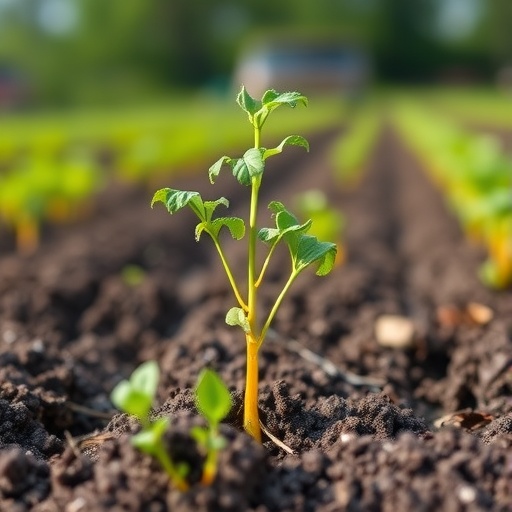In the relentless quest to achieve sustainable agriculture, the intricate relationships between soil management practices and the microbial communities inhabiting the plant root environment have become a pivotal area of scientific inquiry. A recent groundbreaking study by Wang, Xin, Song, and colleagues sheds new light on how tillage practices combined with stover return alter both the endosphere and rhizosphere microbiomes, unveiling implications that could transform crop productivity and soil health management across diverse agroecosystems.
Tillage, the mechanical manipulation of soil, has long been a cornerstone of conventional farming methods. However, it is increasingly scrutinized for its potentially deleterious effects on soil structure, organic matter content, and microbial diversity. This study distinguishes between conventional tillage and no-tillage practices carried out in fields where crop stover—the residues left after harvest—is returned to the soil, an approach championed for its ability to enrich soil organic matter and enhance carbon sequestration. By marrying these tillage regimes with stover return, researchers have sought to decipher how such integrated practices shape the bacterial communities residing within the root interior (endosphere) and the surrounding soil (rhizosphere).
The endosphere encompasses microbial populations that colonize internal root tissues, intricately interacting with the host plant in nutrient exchange and immunological processes. Meanwhile, the rhizosphere represents the narrow soil zone subject to intense root secretions, supporting a dense and dynamic microbiome crucial for nutrient cycling and disease suppression. Both microbial habitats, though closely linked, respond differently to agricultural interventions. Unraveling their distinct microbiome shifts under varying tillage and residue management regimes provides a nuanced understanding of plant-soil-microbiome interactions.
Employing high-throughput sequencing of 16S rRNA genes, the research meticulously profiles bacterial communities, revealing stark contrasts in microbial diversity and composition between tillage methods. No-tillage with stover return significantly enhances the richness of beneficial taxa, fostering a microbial milieu associated with nutrient mobilization and disease resistance. Conversely, conventional tillage disrupts the microbial networks, reducing overall biodiversity and potentially impairing soil functions vital for crop resilience.
Moreover, the study delves into functional predictions of microbial communities, highlighting that no-tillage practices coupled with stover retention enrich metabolic pathways linked to nitrogen fixation, cellulose degradation, and phytohormone biosynthesis. These functions play a critical role in improving soil nitrogen availability, organic matter decomposition, and plant growth regulation, collectively underpinning sustainable yield enhancements. Tillage, in contrast, tends to diminish these critical functional capacities, underscoring the ecological trade-offs inherent in intensive soil disturbance.
Beyond composition and function, the spatial heterogeneity of microbial colonization within plant roots is profoundly influenced by soil management. The endosphere microbiota under no-tillage and residue return appears more stable and less susceptible to pathogenic invasion, suggesting a strengthened plant defense facilitated by a diversified microbial consortium. This microbiome fortification can translate into improved disease tolerance and reduced dependency on chemical inputs, a key objective for eco-friendly agriculture.
Crucially, the research integrates physicochemical soil parameters, revealing that soil organic carbon and moisture retention are enhanced under no-tillage systems with stover retention. These improvements modulate microbial habitats, supporting higher microbial biomass and activity. The synergistic effect of improved soil water dynamics and organic matter inputs creates a conducive environment for microbial proliferation and beneficial plant-microbe interactions, heralding a new paradigm for regenerative soil management.
While the ecological benefits of no-tillage and stover return are becoming clearer, this study also underscores the temporal stability of microbial communities nurtured under these regimes. Long-term field observations indicate that sustained no-tillage practices not only enhance microbial diversity but also promote resilience against environmental stresses such as drought and soil compaction. This temporal dimension is critical in framing sustainable practices that remain effective amid climate uncertainties.
The implications of these findings reverberate beyond microbiology, touching on the global challenge of food security. By fostering a robust root microbiome through conservation agriculture techniques, farmers can potentially reduce fertilizer dependence, cut greenhouse gas emissions associated with synthetic inputs, and improve soil carbon storage. This multifaceted impact positions such management strategies as pillars of climate-smart agriculture, aligning productivity goals with environmental stewardship.
Notably, this research invites a reevaluation of current soil management advisories, advocating for broader adoption of reduced tillage combined with organic residue incorporation. Policy frameworks and extension services must integrate these microbial insights to encourage farmer transitions towards more biologically based soil health practices. Education campaigns emphasizing microbiome benefits could accelerate this paradigm shift in farming communities worldwide.
Furthermore, ongoing advances in metagenomics and microbial ecology could expand upon these initial findings, enabling precision manipulation of root and soil microbiomes for tailored crop benefits. Genetic and metabolic profiling of key microbial players may pave the way for microbiome engineering, where beneficial microbes are selectively enriched or introduced to optimize plant growth and resilience under diverse environmental conditions.
The study by Wang et al. therefore represents a landmark contribution to sustainable agriculture science, opining that microbial community dynamics are a vital nexus linking agronomic practices, soil health, and crop performance. As the agricultural sector navigates the intricacies of environmental challenges and food demands, such techno-ecological insights will be instrumental in designing systems that harness rather than disrupt natural microbial alliances.
In conclusion, this cutting-edge investigation underscores the profound influence that tillage practices and crop residue management exert on the microbiomes within and around plant roots. By revealing that conservation tillage with stover retention cultivates beneficial microbial consortia underpinning soil fertility and plant health, it lights a path toward agronomic strategies that are as scientifically robust as they are ecologically harmonious. Future research expanding on these microbial-plant-soil triads promises to unlock even greater potentials for sustainable intensification, making this work a seminal reference point for scientists, farmers, and policymakers alike.
Subject of Research: Effects of tillage practices combined with stover return on endosphere and rhizosphere microbiomes in agricultural soils.
Article Title: Effects of tillage practices in stover-return on endosphere and rhizosphere microbiomes.
Article References:
Wang, Y., Xin, J., Song, W. et al. Effects of tillage practices in stover-return on endosphere and rhizosphere microbiomes. npj Sustainable Agriculture 3, 57 (2025). https://doi.org/10.1038/s44264-025-00099-5
Image Credits: AI Generated




